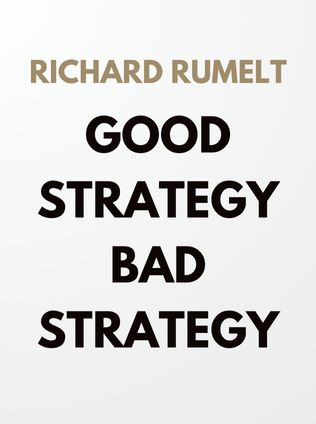
Good Strategy Bad Strategy
The Difference and Why It Matters
By Richard Rumelt
Published 01/2011
About the Author
Richard Rumelt is a renowned strategist and professor at UCLA Anderson School of Management. He has guided various organizations, from small startups to large multinational corporations, and even governmental bodies, including the U.S. Department of Defense. His extensive experience in strategy formulation and execution has made him a leading authority in the field. His book, Good Strategy Bad Strategy, is celebrated for its clear distinction between effective and ineffective strategic practices and its practical guidance on developing sound strategies.
Main Idea
Good Strategy Bad Strategy by Richard Rumelt explores the essential components of effective strategy and the common pitfalls that lead to poor strategy. The book emphasizes that good strategy is about leveraging strengths against weaknesses and provides a framework for diagnosing challenges, formulating guiding policies, and implementing coherent actions to achieve organizational goals.
Table of Contents
- Introduction
- The Two Truths of Strategy
- Bad Strategy
- Good Strategy Starts With a Kernel
- Nine Elements of Good Strategy
- How to Think Like a Strategist
Introduction
In Good Strategy Bad Strategy, Richard Rumelt sets the stage by defining what constitutes good and bad strategy. He explains that good strategy involves a clear understanding of the challenges faced, the formulation of guiding policies to address these challenges, and the development of coherent actions to implement these policies. Bad strategy, on the other hand, is characterized by vague goals, lack of focus, and an overreliance on fluff and motivational slogans.
The Two Truths of Strategy
To understand strategy, Rumelt outlines two fundamental truths: having a strategy is itself a strategy, and good strategy uses hidden strengths.
“Simply having a strategy is a strategy. Most organizations operate reactively without a clear long-term plan.” - Richard Rumelt
Having a Strategy
Rumelt emphasizes that many organizations operate without a clear strategy, responding reactively to challenges. By having a well-thought-out strategy, an organization gains a competitive advantage. He cites Apple’s turnaround under Steve Jobs, who simplified the company’s focus and implemented a clear strategy to address its core problems.
Apple was on the brink of collapse when Jobs returned. He identified the company’s lack of focus as the primary issue and streamlined its product line to concentrate on a few key products. This focused approach, coupled with innovative marketing and product development, helped Apple regain its position as a market leader.
Using Hidden Strengths
Good strategy leverages unexpected strengths against unknown weaknesses. Rumelt uses the example of Walmart, which identified KMart’s decentralized structure as a weakness and capitalized on its own centralized system to outmaneuver its competitor.
“Good strategy leverages strength against weakness, especially an unexpected strength against an unknown weakness.” - Richard Rumelt
Walmart’s centralized distribution system allowed it to respond quickly to market changes and maintain lower inventory costs. This efficiency gave Walmart a significant advantage over KMart, which struggled with its decentralized structure. As a result, Walmart was able to offer lower prices and better service, leading to its dominance in the retail industry.
Bad Strategy
Rumelt identifies four characteristics of bad strategy: fluff, failure to identify the challenge, conflation of goals with strategy, and misguided strategic objectives. He also explains three primary causes of bad strategy: the inability to choose between competing values, the lure of strategy-by-template, and the false promise of positive thinking.
“Bad strategy is not simply the absence of good strategy, but rather a set of strategies based on misconceptions and misguided leadership.” - Richard Rumelt
Fluff
Fluff refers to the use of grandiose language and jargon to create the illusion of expertise. It often masks the absence of a clear strategy. Fluff can be found in many corporate mission statements and annual reports that are filled with vague and lofty language but lack concrete plans for achieving stated goals.
An example of fluff is a statement like “We will leverage our core competencies to drive market leadership and maximize shareholder value.” This sounds impressive but doesn’t provide any specific actions or strategies to achieve these goals.
Failure to Identify the Challenge
A good strategy must define the specific challenge it aims to address. Without a clear understanding of the problem, it is impossible to develop an effective strategy.
Sign up for FREE and get access to 1,400+ books summaries.
You May Also Like
Rich Dad Poor Dad
What the Rich Teach Their Kids About Money - That the Poor and Middle Class Do Not!
By Robert T. KiyosakiFreakonomics
A Rogue Economist Explores the Hidden Side of Everything
By Steven D. Levitt and Stephen J. DubnerThe Lean Startup
How Today's Entrepreneurs Use Continuous Innovation to Create Radically Successful Businesses
By Eric RiesWho Moved My Cheese?
An Amazing Way to Deal with Change in Your Work and in Your Life
By Spencer Johnson, M.D.Factfulness
Ten Reasons We're Wrong About the World – and Why Things Are Better Than You Think
By Hans RoslingMake Your Bed
Little Things That Can Change Your Life...And Maybe the World
By William H. McRaven



















